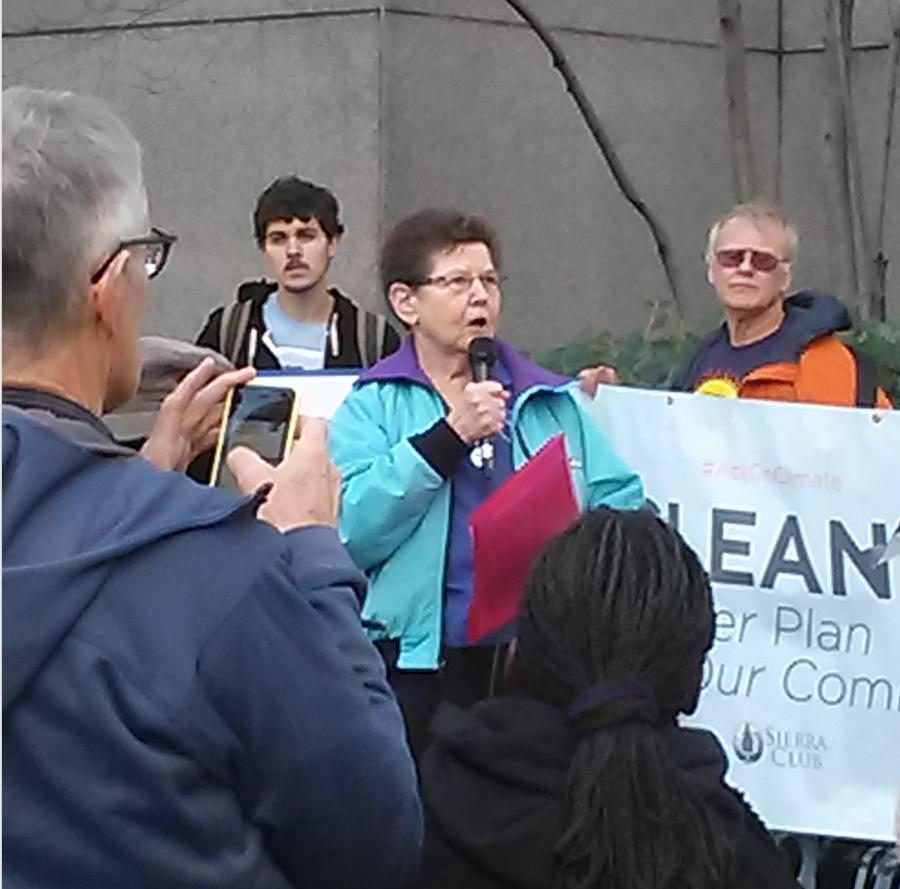As passing drivers honked their support, environmental activists at a Downtown rally Thursday waved signs reading, “Put People and Planet First,” “Make Our Energy Clean — Make it American” and “Protect Our Communities: Clean Air Now.”
About 150 activists, including Pitt students, rallied outside the William S. Moorhead Federal Building, showing their support for the Environmental Protection Agency’s recently announced Clean Power Plan — and for two of the plan’s most influential supporters, Bob Casey, D-Pennsylvania, and Pennsylvania Gov. Tom Wolf.
On Aug. 3, President Barack Obama and the EPA released the Clean Power Plan, which establishes limits on how much carbon pollution power plants may emit. These limits, the first-ever national standards restricting carbon pollution, aim to reduce carbon dioxide emissions to 32 percent below 2005 levels by 2030. According to the U.S. Energy Information Administration, the United States emitted 6,055.2 million metric tons of carbon dioxide in 2005.
“The Clean Power Plan is a really historic step toward fighting climate change,” Eva Resnick-Day, a Pitt graduate who works for the Sierra Club in Pittsburgh and who helped organize the rally, said.
Organizers timed the rally to coincide with the first of four EPA-hosted public hearings at which anyone may air their opinions and concerns about the Clean Power Plan. This hearing, which lasted from 9 a.m. to 8 p.m. Thursday and will continue from 9 a.m. to 5 p.m. Friday, took place inside the Moorhead Federal Building.
During Thursday’s session, some members of the public expressed support for the plan, while others harshly criticized it, claiming it won’t go far enough in addressing carbon pollution’s contribution to climate change. The EPA will hold three more hearings later this month in Washington, D.C., Denver and Atlanta.
The federal Clean Power Plan serves as a model for each state to develop its own plan for governing power plants within its borders, providing what the EPA and Casey both say is necessary versatility.
“I appreciate the consideration that the administration has given to the needs of states like Pennsylvania when it comes to implementation,” Casey said in a statement after the Clean Power Plan was announced, citing the plan’s flexibility as a strength.
Wolf issued a similar statement after the Clean Power Plan was announced in August, saying he supported the plan and was committed to making sure Pennsylvania could protect jobs while reducing carbon emissions.
State plans modeled on the federal Clean Power Plan are due in September 2016, although states may request up to two years of extra time. If a state doesn’t submit an acceptable plan to the EPA by September 2018, however, that state will be forced to follow the federal plan.
The Pennsylvania Department of Environmental Protection will create Pennsylvania’s state-specific plan. Neil Shader, the DEP’s press secretary, said the DEP plans to start work on the plan today, Nov. 13, and to have a plan ready by the September 2016 deadline.
Stephanie Walton, a spokesperson for FirstEnergy, said her company is still reviewing the Clean Power Plan to determine how it might affect its business. FirstEnergy, based in Akron, Ohio, operates power plants throughout the mid-Atlantic, including the coal-fired Bruce Mansfield Power Plant and the nuclear Beaver Valley Nuclear Power Station, both located about 25 miles northwest of Pittsburgh in Shippingport, Pennsylvania.
“It’s a little too soon to say how a particular plant will be affected,” Walton said, citing the fact that states could wait until September 2018 to submit plans if they ask for the maximum extension. Walton did mention that plants fired by gas, oil or coal will probably face more restrictions than nuclear plants or wind farms.
“The rule is aimed at existing power plants that run on fossil fuels,” Walton said.
At Wednesday’s rally, Alex Stash, a Pitt environmental science major and president of Free the Planet, reminded attendees that climate change and pollution affect disadvantaged communities around the world.
“A lot of the people here were really focused on Pittsburgh, and that’s so important,” Stash said after the rally. “But there are parts of the world that are way worse off.”
Resnick-Day hopes the Clean Power Plan can assist those who live in those areas.
“There’s a lot of opportunities there to make sure the federal plan protects minority, low-income and indigenous communities, who have traditionally borne the brunt of climate change,” Resnick-Day said. For example, she suggested that the plan should maximize incentives for low-income families to use low-impact energy sources for their utilities.
Resnick-Day gave the rally’s closing remarks, during which she held up a sign with Casey’s office phone number and exhorted the audience to thank him for his support. Stash said that she thought the organized call was a great idea and that she plans to do the same thing at a future Free the Planet meeting.
“We’ve seen, time and time again, decisions made about our climate and our Earth made behind closed doors,” Corby said. “But that strategy doesn’t work when people show up.”
Inside at the EPA hearing, testifiers spoke more quietly but with no less intensity.
Taryn Jones, a Detroit resident representing community organizing groups Michigan United and National People’s Action, told EPA representatives that the Clean Power Plan must reduce pollution’s impact on communities of color and low-income individuals, who often can’t afford to treat the illnesses pollution causes.
“Do you know what it feels like to walk outside and feel like you’re going to die because you’re gasping for air that’s so smog filled, there isn’t enough oxygen per cubic inch to breathe?” Jones, who suffers from severe asthma and chronic bronchitis, asked.
Elizabeth Kerr, the communications director for Business Forward, a trade association of business leaders, testified that the Clean Power Plan won’t damage American industry.
“Critics argue new EPA standards will cause American manufacturers to shut down their U.S. factories,” Kerr said. “But if you take into consideration what manufacturers actually spend on electricity — and how that spending relates to the rest of their budgets — you’ll find that projected rate increases will have a small impact on manufacturers’ bottom lines.”



